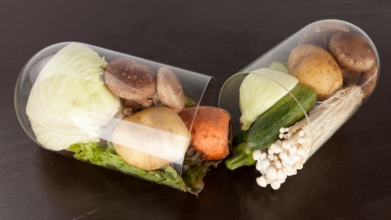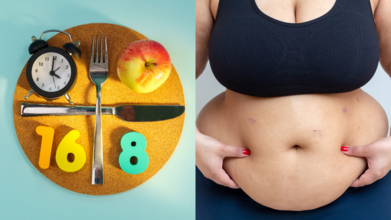- Health Conditions A-Z
- Health & Wellness
- Nutrition
- Fitness
- Health News
- Ayurveda
- Videos
- Medicine A-Z
- Parenting
- Web Stories
Wednesday's Jenna Ortega Eats Kiwi With The Skin On - Is That Healthy, Doctor Weighs In

(Credit-Jennaortega/Instagram)
Jenna Ortega, known for playing the beloved Addams Family character Wednesday, recently posed a video exclaiming how she ‘recently’ found out you can eat kiwis with its skin on, which has sparked a great deal of conversation about whether it is healthy or not.
We are all used to either cutting out the fuzzy skin of kiwis or cutting it in half and scooping out the soft fruit flesh from the inside. However sometimes, just because we are used to something, doesn’t mean it is right. For a long time, peeling fruits was a norm and people thought it was necessary to do, to be safe. However, recently we have seen more scientific proof of why these fruit peels is not only edible but have hidden benefits.
Weighing in on this conversation gastroenterologist Dr. Joseph Salhab and registered dietitian Gillian Culbertson posted a video explaining how this is actually a good practice.
Can You Eat Kiwi With Skin On?
Eating the kiwi skin can significantly boost the fruit's nutritional power. Dr Salhab and Culbertson explain that the skin is loaded with
More Fiber
Eating the skin increases the kiwi's fiber content by up to 50%. This is great for your digestive system, helping to prevent constipation and support a healthy gut.
More Vitamins
You'll get more vitamin C and vitamin E, which support liver health and your immune system. The skin also adds extra folate, magnesium, and vitamin B6.
Rich in Antioxidants
The skin contains three times more antioxidants than the fruit itself. These include polyphenols and vitamin C that fight inflammation and help protect your cells from damage.
What Are The Benefits of Kiwi Skin?
According to the Cleveland Clinic, eating kiwi, especially with the skin on, offers other notable health perks:
- Eating a kiwi two hours before bed can help your body produce melatonin, a hormone that regulates sleep, leading to a better night's rest.
- The fiber and antioxidants help protect the colon from DNA damage, which can lower your risk of colon cancer.
What Are the Risks of Having Kiwi Skin?
While kiwi skin is packed with nutrients, it's not for everyone. If you have a history of kidney stones, you should avoid eating the skin. The skin contains high levels of oxalates, which are natural substances that can bind with calcium in your body. This can lead to the formation of crystals in your kidneys, increasing your risk of developing painful kidney stones. It's much safer for you to simply enjoy the fruit on its own and throw away the skin. If you're ever in doubt, it's always best to check with your doctor first.
Tips for Eating Kiwi Skin
If the idea of eating a kiwi with its fuzzy skin doesn't appeal to you, don't worry—you have options.
Try a Golden Kiwi
The golden kiwi has a smooth, fuzz-free skin that's much easier to eat than its green counterpart.
Scrub the Fuzz Off
For green kiwis, you can gently scrub the skin with a kitchen towel or vegetable brush while rinsing it under water. This will help remove the fuzzy texture and make it more pleasant to eat.
Blend It
The easiest way to get all the benefits of the skin without even noticing it is to throw a whole kiwi into a smoothie. The blender will break the skin down into tiny, unnoticeable pieces.
Nutritionist Explains Why Relying On Supplements Alone Is Not Enough

Credits: Canva
When it comes to health, there are no magic shortcuts. “Health is cultivated daily, in small, consistent ways,” said celebrity nutritionist Rujuta Diwekar on the episode of All About Her, a podcast hosted by Soha Ali Khan that focuses on women’s nutrition and wellness. Diwekar explained why supplements alone can never replace the essentials of good health, home-cooked food, quality sleep, daily movement, and mindful living.
Supplements Should Complement, Not Replace
According to Diwekar, supplements can only serve their purpose when they are built on top of a strong foundation of healthy habits. Relying solely on pills, powders, or protein shakes while neglecting real food, exercise, and rest does more harm than good. “If your entire focus is on products at the cost of eating home-cooked food, working out, and sleeping well, then it’s not worth it,” she said. Supplements should be seen as supportive tools, not substitutes.
Fitness Doesn’t Need To Be Expensive
A common misconception is that fitness requires costly gym memberships, imported superfoods, or a stack of supplements. Diwekar challenged this belief, stressing that true health is rooted in affordable, sustainable choices. Eating local, seasonal produce and sticking to consistent routines are far more effective than chasing expensive quick fixes. In her words, wellness becomes accessible when we look at what’s around us rather than what is marketed to us.
The Influence of Social Media Trends
The growing culture of influencers promoting supplements was another concern Diwekar highlighted. Many online personalities push powders, pills, and products without disclosing paid partnerships, leaving followers misinformed. This often leads people to buy into the illusion of quick results instead of cultivating habits that bring long-term benefits. Diwekar urged listeners to be cautious about influencer-driven trends and to prioritize their own health signals over marketing hype.
Holistic Health Goes Beyond Food
Nutrition is only one piece of the puzzle. Diwekar reminded her audience that sleep, stress management, and emotional well-being are just as crucial as what we put on our plate. A balanced lifestyle, where rest, relaxation, and movement align with nutrition, creates resilience and lasting wellness. Short-term fads may show quick results, but consistency is the true marker of good health.
Listening To Your Body
Another key takeaway was the importance of tuning into one’s own body. Recognizing signals of hunger, satiety, and energy levels helps individuals build routines that suit their unique needs. Diwekar emphasized that no one-size-fits-all diet or supplement plan can replace personal awareness. Paying attention to your body’s cues is far more effective than blindly copying celebrity-endorsed diets or social media challenges.
Ultimately, Diwekar’s advice blends practicality with tradition. Wellness doesn’t require radical changes, it’s about making small, sustainable choices every day. Cooking at home, walking regularly, choosing local ingredients, and prioritizing sleep are habits that make health achievable for everyone. Supplements can support this lifestyle, but they should never be the foundation.
Harvard Doctor Shares 3 Tips To Lose Belly Fat With Intermittent Fasting

Credits: Canva
Those who have belly fat know it is a war when it comes to shedding that fat. It has been fought with everything, from crash diets to endless crunches, but the stubborn midsection just does not go away. Intermittent fasting is not a diet but a way of timing your meals that could help trim that fat. And according to Harvard-trained gastroenterologist Dr. Saurabh Sethi, there are three best tips to lose belly fat with intermittent fasting. One of these is particularly crucial.
Here is how intermittent fasting, done the right way, might finally come to your rescue.
Also Read: No Longer Need 10,000 Steps? 2,500-4,000 Are Enough To Protect Your Heart, Says Doctor
The 12-12 Kickstart
The idea of fasting can sound intimidating. Skipping breakfast or dinner or going without snacks sounds like punishment. But Dr. Sethi suggests starting simple: “First, start with a 12-12 fasting schedule, which is the mildest option. This approach helps you sleep soundly at night and reduces the likelihood of unhealthy food choices the next day."
What does that mean?
You fast for 12 hours (say, 8 pm to 8 am) and eat during the other 12. It is not extreme; you are basically just cutting out late-night snacking and mindless munching. That alone can save you hundreds of calories without you even noticing. Plus, your body finally gets a break from digesting round-the-clock, which helps regulate insulin and metabolism.
Sip Smart During the Fast
If you think fasting means surviving on air, you are wrong. Dr. Sethi is clear: “Second, during your fasting window, only drink black coffee, green tea, black tea, water, apple cider vinegar, lemon water, fennel or basil water, chamomile or ginger tea."
In other words, hydration is key. These drinks not only keep you from feeling bloated but also help curb hunger pangs. Black coffee can give your metabolism a gentle push, while herbal teas like chamomile or ginger soothe your system and reduce bloating. Flavoured waters (lemon, fennel, basil) keep things interesting and refreshing. The trick is: no sugar, no milk, no additions. Pure, clean liquids only.
Why does this matter?
Because breaking your fast with a sugary coffee or fruit juice is like trying to lose weight while eating cake for breakfast. Staying disciplined with what you sip makes intermittent fasting effective.
Build a Plate That Works Harder Than You
Fasting is not a free pass to eat pizza and pastries during your eating window. Dr. Sethi emphasises: “Third, focus on a high-fibre, high-protein diet during your eating window. High-protein foods like paneer, tofu, chickpeas, chicken, turkey, and fish, and high-fibre foods like fruits and veggies. This combination will keep you full and satiated while promoting fat loss."
Protein helps repair and build muscle while keeping you fuller for longer. Fibre slows digestion, keeps blood sugar stable, and gives you that lovely “I’m full, I don’t need dessert” feeling. Together, they form a dynamic duo that not only supports fat loss but also makes fasting easier because you won’t be ravenous when the clock says “no food”.
Intermittent fasting will not melt belly fat overnight, and you still need to eat mindfully. But when done consistently, it can create a calorie deficit, improve metabolic health, and reduce cravings that hamper your goals. And you do not have to cut out entire food groups or live with greens. You just have to learn when to eat, what to sip, and how to build your plate.
RFK Promotes Full-Fat Milk Over Whole Milk, What's The Health Factor?

Credits: AP, Canva
For nearly 50 years, the U.S. government has urged Americans to avoid whole milk. The shift began in the late 1970s, when rising rates of obesity and heart disease led to strict recommendations: drink low-fat or skim milk, limit cheese, and keep saturated fat to a minimum. These guidelines became official in 1980, shaping what schools served, what food aid programs provided, and even how families stocked their refrigerators.
Now, that long-standing stance may soon change.
Kennedy Pushes for a Policy Reversal
Health and Human Services Secretary Robert F. Kennedy Jr. has repeatedly argued that full-fat dairy deserves government endorsement. Backed by President Donald Trump, Kennedy is spearheading the “Make Our Children Healthy Again Strategy,” a plan that would allow whole milk in public schools and the Women, Infants, and Children (WIC) assistance program.
The move is part of Kennedy’s broader “Make America Healthy Again” campaign, which encourages eating less processed food and re-examining decades of nutritional advice. Unlike some of his more controversial positions, such as promoting raw milk or questioning vaccines, this proposal has mainstream support. Dairy farmers, nutritionists, and even some public health experts agree the science on dairy fat may have been misunderstood.
Is Whole or Skim Milk Healthier?
For decades, the case against whole milk rested on one concern: saturated fat. Experts feared it clogged arteries, contributed to diabetes, and drove obesity rates higher.
But the evidence has never been airtight.
Randomized trials have not proved that low-fat milk is healthier than whole milk, while newer research suggests dairy fat may actually help regulate blood sugar, improve satiety, and slow digestion.
A 2020 meta-analysis of 28 studies found mixed results, in most, children who drank whole milk were less likely to be overweight, but in others, milk type made no difference. Some researchers now argue the distinction between whole and low-fat dairy may not matter as much as once thought.
Read: Why Does RFK Want Whole Milk To Return To Schools?
As cardiologist Dariush Mozaffarian of Tufts University put it: “Dairy fat was given a wrongful conviction in 1980. Forty-five years later, that wrongful conviction might be overturned,” as reported by the Washington Post.
What Health Organizations Still Say
Despite shifting research, most health authorities continue to recommend low-fat dairy for children over age two and for adults. Their advice remains consistent: limit saturated fat to under 10 percent of daily calories (or 6%, in the case of the American Heart Association).
U.S. Dietary Guidelines for Americans: Whole milk for toddlers; skim or 1% for older children and adults.
American Heart Association: Whole milk for toddlers; skim, 1 percent, or 2% for older groups.
American Academy of Pediatrics: Whole milk for toddlers unless obesity risk is high; skim or 1% afterward.
World Health Organization: Breastfeeding preferred for infants; whole milk acceptable for older babies; saturated fat capped at 10% of daily intake.
This gap, between official recommendations and newer research, is at the heart of Kennedy’s push.
Industry Support for Whole Milk
Dairy groups have lobbied for years to bring back whole milk in schools and food programs. Producers argue consumers are already shifting toward higher-fat products as newer studies cast doubt on the dangers of dairy fat.
“It’s time for federal nutrition policy to catch up with the science,” said Andrew Jerome of the International Dairy Foods Association to the Post. The National Milk Producers Federation has also pressed the government to give families more choice.
Sales trends reflect this change: while 2% milk remains the most popular, whole milk consumption has been climbing slowly over the past decade.
Also Read: 5 Cow’s Milk Substitutes—And What To Look For Before You Buy
The Politics Behind Milk
Kennedy has criticized the current dietary guidelines as “antiquated” and too lengthy, promising to replace the 149-page report with a shorter version focused on whole foods. He has also called for re-elevating milk, cheese, and yogurt as central to children’s health.
The Trump administration’s upcoming dietary guidance is expected to highlight whole milk as a healthy choice, though it has remained silent on flavored milks like chocolate or strawberry. These remain available in reduced-fat varieties, despite concerns over high sugar content.
Critics, however, caution against rushing to rewrite policy. Erin Ogden of the Center for Science in the Public Interest warned and told the Post that saturated fat is still linked to health risks: “There hasn’t been enough evidence indicating that the source of saturated fat changes its impact on the body.”
What Comes Next
Most public schools have been barred from serving whole milk since 2010, when a law signed by President Barack Obama tied lunches to federal nutrition guidelines. The WIC program follows the same rules, restricting families from buying whole milk for children over age two.
That could soon change. If the administration finalizes Kennedy’s proposals, both school lunches and WIC benefits may once again include whole and 2 percent milk. Kennedy has pledged to complete an overhaul of the dietary guidelines by the end of the year.
“The attack on whole milk and cheese and yogurt has gone on for decades,” Kennedy said recently. “It’s time to elevate those products to where they belong in contributing to the health of our children.”
© 2024 Bennett, Coleman & Company Limited

